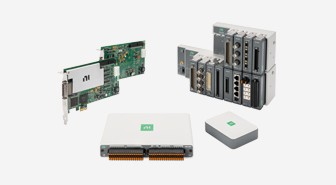
Some remember a time when not every house had a TV, not every kitchen had a microwave, and not every pocket had a phone. It’s an ongoing phenomenon: The more technology advances, the wider the accessibility.
Accessibility to technology and information is powerful. Whether it’s a commuter checking their maps app to determine the best route to drive home or a student using generative AI to do homework, various tech tools are enabling people to do things better and more quickly.
Likewise, improved accessibility to technology, data, and software is helping engineers do their jobs better. Technological advancements are ushering in a new era of data acquisition (DAQ) to boost access to precision measurements and data.
Let’s take a look at some key trends making DAQ instrumentation more accessible for engineering teams and enabling organizations to boost quality and stay competitive.
The Four Drivers of DAQ Accessibility
The concept of access combines functional value (what can a device do), and user experience (how easy is it to use). Strides in technology have delivered improved USB standards and advanced ADC designs while market-leading vendors recognize the importance of ease of use and software flexibility.
Next-Generation USB
In the past, engineers faced a trade-off between convenience and performance in DAQ systems. For quick, on-the-go measurements or at the desk, USB DAQ options were lower-quality devices that sacrificed resolution and features but offered utility and portability. High data throughput tasks were reserved for instruments or more powerful PXI systems in the lab.
Thanks to improved USB technology, data acquisition devices have more bandwidth and power at their disposal. For example, it’s common for laptops to support 5/10 Gbps over USB 3.0/3.1 respectively. And the power available for many laptop-connected devices has jumped from 2.5 W with USB 2.0 to significantly more with the USB 3 series.
As a result, USB has become a viable bus for higher-performance data acquisition, providing power and speed through a single cable and making quality, high-speed measurements readily accessible to every test lab professional, right at their desk.
Improvements in ADC Technology
As with any technology, analog-to-digital converter (ADC) designs are getting better, faster, and more power efficient. For example, the recently released AD4858 from Analog Devices boasts eight simultaneous sampling, 20-bit inputs clocked at up to 1,000,000 samples per second. And this design uses a mere 45 mW per channel at 1 MSPS.
The improved ADC performance and power efficiency, combined with the latest USB standards, bring measurement capabilities once reserved for wall-powered, larger systems to small, portable devices that take up little space on a desk.
As a result, engineers can measure multiple power rails, test device battery performance, generate digital signals, simulate sensors, and debug control boards in less space than their laptop. The mobility and power of modern USB DAQ instruments enable test professionals to identify and address issues early in the design process, minimizing the risk of costly revisions further in the development pipeline.
Vendor Focus on Ease of Use
In an NI survey of the DAQ market (NI customers and non-customers), 43 percent of respondents revealed that their greatest challenge was setting up the system. Initial frustration often impedes the adoption of tools meant to improve productivity.
A straightforward setup enables lab professionals, regardless of their expertise, to start working efficiently right away. Next-generation USB DAQ instrumentation with Type-C connections combines power and data in a single cable. There is no need to carry an additional power supply, hunt for a vacant power outlet, and no tangled wires—just attach one cord directly from the USB DAQ instrument to the computer.
When detailed product information is required, vendors are finding new ways to make it easy to access. For example, QR codes printed on the actual devices, such as NI’s USB mioDAQ instruments, allow engineers to instantly access pinouts, user manuals, and spec sheets directly from their phones.
With user-friendly USB DAQ instrumentation, engineers can focus more of their attention on electronics validation and spend less time troubleshooting and configuring systems.
Flexible Software Integration
The NI DAQ survey also revealed that 27 percent of users had trouble keeping pace with changing hardware and software technology and 33 percent struggled with interoperability issues. The additional measurements lose value if the new data isn’t accessible or usable for users.
Leading USB DAQ vendors support multiple software workflows for integration with a range of software tools including data loggers, LabVIEW development, or programming support for Python and C/C++. This openness ensures that engineers can leverage their preferred software platforms, languages, and tools while avoiding getting locked into a closed ecosystem or “walled garden.”
This flexibility is especially critical in today’s dynamic tech environment. Whether artificial intelligence (AI) is on the roadmap or not, now is the time to begin collecting data to prepare for future AI initiatives. As engineering teams adopt USB DAQ, they will generate and store vast amounts of valuable electronics validation data. This data will serve as the foundation for advanced analysis using AI and machine learning (ML) models, leading to improved product quality and efficiency improvements through software.
The Need to Do More with Less
Ask any validation engineer, and they will tell you that the pressure to innovate and achieve results in less time with less resources is real. Test engineers need simple, effective solutions that can deliver quick results. Next-generation USB DAQ instrumentation enables engineering teams to quickly address their most pressing challenges.
- Product complexity: Quality becomes a bigger challenge as product complexity grows. There are more variables to test and more dependencies to consider. Ensuring that every component performs reliably and meets regulatory requirements is essential for maintaining market leadership and delivering flawless products.
- Shorten time to market: Market leaders must stay ahead of the competition with rapid innovation and quick deployment of new products. This puts incredible strain on engineering to minimize delays and avoid costly overruns.
- Resource constraints: Tight budgets and limited headcounts are realities that most organizations contend with. Managing costs while ensuring high productivity and quality is a delicate balancing act.
By adopting a proactive approach and integrating advanced USB DAQ instruments into testing protocols and workflows, engineering teams detect quality issues early, fix problems faster, and automate repetitive processes. These benefits deliver tangible results, boosting quality, decreasing time to market, and enhancing lab productivity.
Advancing Engineering with Modern DAQ Solutions
A good example of measurement equipment following (and maybe driving) these trends is NI’s latest USB DAQ device. NI’s mioDAQ can stream 16 channels of 20-bit, 1 MS/s simultaneous data while also generating four waveforms at 250 kS/s simultaneous and 16 digital lines clocked at 10 MHz. All this is done over a single USB cable that moves data and powers the device from a laptop. A QR code on the hardware provides instant access to detailed product information.
Combining a simplified user experience with the high-quality measurements of more sophisticated devices, mioDAQ offers a stress-free setup, unmatched measurement quality, and enhanced software integration. Its compact form fits easily in a backpack or the corner of a desk, making it convenient for electronics validation anywhere.
By supporting various software environments, mioDAQ allows lab professionals to work with the tools that match their domain expertise, skills, and job requirements. They can perform more efficient analysis and leverage data insights to suit their needs without being constrained by restrictive or closed ecosystems.
Adopting mioDAQ provides organizations with immediate short-term benefits while generating data for the eventuality of AI. As AI initiatives materialize, mioDAQ will have already collected plenty of test data to feed the models and facilitate rapid deployments.
Check out how NI and mioDAQ are taking data acquisition to the next level.

